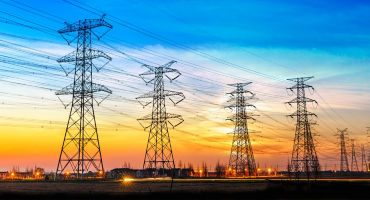- Global Industry Analyst
Skip to main content
- Funds
- Insights
- Capabilities
- About Us
- My Account
The views expressed are those of the authors at the time of writing. Other teams may hold different views and make different investment decisions. The value of your investment may become worth more or less than at the time of original investment. While any third-party data used is considered reliable, its accuracy is not guaranteed. For professional, institutional, or accredited investors only.
The US Inflation Reduction Act (IRA) is a historic piece of legislation that should lower the cost of the energy transition, spur innovation, and transform the US clean power and clean infrastructure industries. The law assures US$387 billion for solutions (Figure 1), with subsidies potentially amounting to far more over time, given resulting demand generation. And while the IRA primarily supports climate mitigation initiatives — reducing greenhouse gas (GHG) emissions to forestall the worst effects of climate change — it also incentivizes spending on climate adaptation and resilience.
Who stands to benefit most from the law’s deflationary objectives? In our view, industries like clean-power technology and electric utilities, which enable the economy to transition to renewable energy and reduce reliance on fossil fuels, are the most directly and positively affected. Developers and manufacturers along the solar and wind value chain could also see a boost, as could emerging technologies like green hydrogen and energy storage. Last, but not least, the law is a positive for US consumers, who should benefit from lower electric bills and less fluctuation in costs over time.
The IRA should drive demand and support clean power economics, with particularly meaningful tailwinds for subsectors that will benefit from new or revived tax credits, especially those refundable in cash.
For large-scale solar, a 30% transferable investment tax credit:
For small-scale solar, a 30% investment tax credit:
For wind, a US$26/MWh production tax credit:
For energy storage, a new 30% investment tax credit:
For green hydrogen, a US$3 per kilogram production tax credit:
For domestic renewables manufacturers receiving refundable tax credits:
For nuclear, new production credits:
For new technologies, the IRA provides a boost for:
The IRA further supports fundamentals in this sector, which was already benefiting from a decades-long trend of decarbonization, electrification, and a supportive regulatory environment. Potential acceleration from the IRA may increase projected regulatory asset base growth by 1% per year, from 6% – 7% to 7% – 8%. With expected 6% – 8% compound annual earnings-per-share growth, plus a 3% – 4% dividend yield, we see the potential for 10% per annum total returns for the sector through the end of the decade2. Additionally, states that have not traditionally concentrated on renewable energy should eventually implement clean-energy transition plans as this process becomes more economical for ratepayers. Asset sales in the unregulated renewable space could also increase and command higher valuations given greater residual asset values. Overall, for utilities, the IRA:
We expect the IRA to provide a boost for the rest of the solar and wind value chain, including developers, non-US suppliers, and lenders. In our view, while mainstream renewables now have a decade-long runway of stability and visibility of costs, the incremental growth trajectory is likely to be more modest than what current media headlines suggest. As Figure 2 shows, the IRA should have a positive net impact on solar demand. Absent the IRA, renewables demand would still have been strong from state and corporate mandates, but it would have been lumpier, due to the previously expiring credits. The IRA represents an evolutionary, not revolutionary, solar demand driver for two main reasons:
Before the law’s passage, the average US household electric bill was projected to increase by 2% – 2.5% per year over time, to support costs associated with the low-carbon energy transition and electrification of the economy3. Passage of the IRA potentially enables utilities to reduce the annual projected bill increase by up to 0.5% — 1%. (Note that the 2% – 2.5% range is before accounting for potential fluctuations in electric bills caused by fuel-cost pass-throughs.) Given the recent price spike in energy commodities like natural gas and coal amid Russia’s war in Ukraine — spurring spikes in electric bills — the IRA’s deflationary nature could prove even more valuable to consumers in the near to medium term.
For a broader take on the economic implications of this landmark legislation, please see 'Inflation Reduction Act: A big deal for the US economy
As a side note, we will be watching the US Congressional agenda for an upcoming bill, sponsored by West Virginia Senator Joe Manchin, which may include:
Easier permitting would facilitate the expansion of natural gas pipelines (or hydrogen pipelines, eventually) and electric transmission lines. We view permitting reform as imperative to achieving the goals of the IRA.
1Projections based on Wellington Management research. | 2Projections based on Wellington Management research. | 3Projections based on Wellington Management research.




Growth vs stability: do infrastructure investors really have to pick a side?
Continue readingPower play: Building the case for infrastructure in 2025
Continue readingURL References
Related Insights
Stay up to date with the latest market insights and our point of view.

Growth vs stability: do infrastructure investors really have to pick a side?
There’s a buzz around infrastructure at the moment. But do listed infrastructure investors really have to invest in cyclical businesses in order to benefit from structural tailwinds? Tom Levering and Joy Perry explore another way.

Power play: Building the case for infrastructure in 2025
The long-term case for listed infrastructure remains compelling. But could near-term catalysts, such as nuclear and natural gas, also drive performance in the short term?

URL References
Related Insights